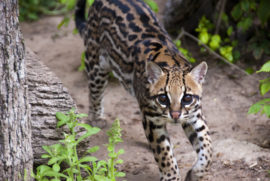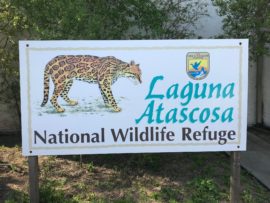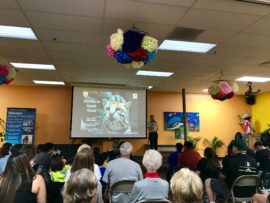Texans are Protecting Federally Endangered Ocelots

Here in Houston we are all very familiar with the presence of Cougars – if the mention of this species doesn’t bring a certain university to mind, the name Shasta just might! While Shasta is quite the local celebrity, there is another Texas cat making the news a few hours south of us – the ocelot. The city of Brownsville is leading the charge to save the federally endangered ocelot, and thanks to your visit to the zoo, we’ve been able to lend a hand by providing 10 refurbished tracking collars that will help local programs keep tabs on their ocelot population.
Ocelots are endangered within the United States with less than 100 individuals in one region-south Texas. Their main threats include habitat loss (more people means more land used for agriculture, oil/gas, homes, etc.) and collisions with vehicles on roads.

One method to save ocelots in south Texas is to create roads that are safe for both animals and humans Several years ago, in an attempt to make roads safer for Brownsville locals and visitors headed to vacation on South Padre Island, concrete barriers were put in place to separate cars traveling in opposite directions. This measure helps protect drivers on the road, but unfortunately made it difficult for ocelots to cross to the other side of the road to get to remaining patches of habitat (their small size makes it difficult to see cars on the other side of the barrier, so they aren’t sure when it’s safe to attempt to cross). When it became clear that the barriers were a hazard for the ocelots, the people of Brownsville came together and asked the Texas Department of Transportation (TxDOT) to come up with a way to keep both humans and local wildlife safe.
In response to the public’s concern for the ocelots, TxDOT has joined forces with the U.S. Fish and Wildlife Service (USFWS) to build 12 tunnels beneath two roads that cut through or border the Laguna Atascosa Wildlife Refuge, where many of the endangered cats go in search of a safe place to live. On these tunnels, chain link fencing extends from above the underpass and along the sides to help funnel the cats to the under-the-road crossings, which are large enough for the cats to see what’s on the other side. This is a huge undertaking for TxDOT, who is both building the tunnels and helping to monitor their use, in order to determine what species in the area actually choose to travel via the underpasses. While it is too soon to tell which species are using the tunnels most frequently, TxDOT did spot an ocelot on one of their motion sensor cameras by a tunnel opening just last month, which has sparked excitement and hope for what is to come.

There is a lot of love for ocelots in south Texas, which is evident through the community’s effort to make these wildlife underpasses a reality. The ocelot is even celebrated annually at the Ocelot Conservation Festival and Ocelot run – events that are organized by the Friends of Laguna Atascosa and hosted by Gladys Porter Zoo. Many landowners are also actively involved in saving ocelots by setting aside land that serves as preserved natural habitat for the cats. We may be a 6 hour drive from Brownsville, but despite the distance you’re saving ocelots too each time you visit the zoo! On your next trip make sure to say hello to Jack, our resident ocelot.
For the 11th annual Wildlife Conservation Gala at the Houston Zoo, we’re shining a spotlight on the species and habitats of the Lone Star State! We’ll come together as Texans to raise the funds our Zoo needs to keep saving Texas wildlife like ocelots.
